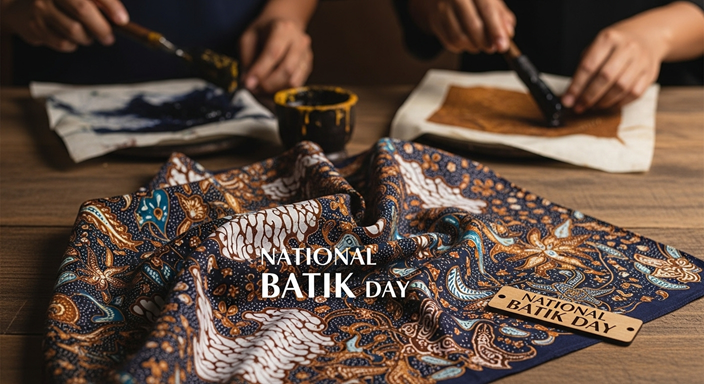Every year on October 2nd, the people of #Indonesia come together to celebrate National Batik Day (#NationalBatikDay), a cultural festival that honors one of the country’s most treasured art forms — #Batik. The day not only reflects the creative #craftsmanship of Indonesia but also recognizes batik as a symbol of national #identity, #pride, and #unity. In 2009, #UNESCO acknowledged batik as a Masterpiece of Oral and Intangible Heritage of Humanity, giving Indonesians even more reason to cherish this tradition. National Batik Day is more than just about clothing; it is a celebration of #heritage, #culture, and #continuity.
History of National Batik Day
The roots of National Batik Day are deeply tied to Indonesia’s cultural history. Batik itself has been part of the country’s identity for centuries, with evidence of its use dating back to the 13th century in Java. Traditionally, batik was reserved for the royal courts and nobility, but over time, it became part of the daily lives of Indonesians.
The official celebration of National Batik Day began in 2009, after UNESCO recognized Indonesian batik as an Intangible Cultural Heritage of Humanity on October 2nd of that year. The recognition was the result of dedicated efforts by the Indonesian government, cultural groups, and artisans, especially under the leadership of the Ministry of Culture and Tourism. The acknowledgment by UNESCO not only highlighted the uniqueness of batik but also placed Indonesia on the global cultural map.
Since then, October 2nd has been observed annually as National Batik Day, marked by a sense of pride and unity across the archipelago.
Importance of National Batik Day
National Batik Day is important because it is not only a celebration of a craft but also a reaffirmation of Indonesian identity. Batik is more than just fabric — it tells stories, reflects traditions, and preserves cultural values. The patterns, motifs, and techniques carry symbolic meanings, often associated with philosophy, spirituality, and regional identity.
The day holds importance for several reasons:
-
Cultural Preservation – Batik-making is a centuries-old tradition, and celebrating the day ensures it is passed down to younger generations.
-
National Unity – Batik is worn by Indonesians across different regions, religions, and social classes, making it a unifying cultural symbol.
-
Global Recognition – UNESCO’s acknowledgment elevated batik from a local tradition to a global treasure.
-
Economic Impact – Batik is an industry that sustains thousands of artisans, contributing to Indonesia’s economy.
-
Educational Value – The day inspires schools, universities, and communities to teach the art of batik to students, ensuring continuity.
Significance of National Batik Day
The significance of National Batik Day lies in its ability to keep Indonesia’s cultural heritage alive in a rapidly modernizing world. It is a reminder of the artistry, patience, and creativity required to create batik. The day also reinforces a sense of belonging and pride among Indonesians.
Globally, batik represents Indonesia on the world stage. When foreign dignitaries wear batik during international events, it signals cultural respect and recognition. Batik has thus become a soft power tool for Indonesia, symbolizing elegance, craftsmanship, and diversity.
Why National Batik Day is Celebrated
National Batik Day is celebrated to:
-
Honor UNESCO’s recognition of batik as a world cultural heritage.
-
Celebrate the artisans who dedicate their lives to preserving batik traditions.
-
Promote batik as a national symbol that unites the diverse islands and cultures of Indonesia.
-
Educate the younger generation about the history and artistry of batik.
-
Encourage international appreciation of batik as a unique Indonesian contribution to world culture.
In essence, the celebration is about pride, preservation, and promotion of one of Indonesia’s greatest treasures.
How National Batik Day is Celebrated
National Batik Day is celebrated with enthusiasm across Indonesia. Some of the ways include:
-
Wearing Batik – On October 2nd, government officials, schoolchildren, office workers, and citizens proudly wear batik to work, school, and public events.
-
Educational Activities – Schools organize batik-making workshops to teach children the art and meaning of batik patterns.
-
Exhibitions and Fairs – Cultural centers host exhibitions showcasing batik fabrics, history, and innovations.
-
Parades and Performances – Fashion shows, parades, and musical events highlight the beauty of batik in contemporary life.
-
Community Involvement – Local artisans demonstrate batik-making techniques, allowing citizens to engage directly with the craft.
The celebrations are not just formal but also deeply personal, with families and communities proudly sharing their batik heritage.
Where the Day is Celebrated
National Batik Day is primarily celebrated in Indonesia, but its influence spreads worldwide. Indonesian embassies and consulates in different countries organize cultural programs to mark the day.
-
Indonesia: Every province, from Java to Sumatra to Kalimantan, takes part.
-
Malaysia and Singapore: With shared cultural ties, batik is also respected and celebrated.
-
The Netherlands: Due to historical links, batik exhibitions often take place.
-
Global Indonesian Communities: Indonesians abroad wear batik on October 2nd to showcase their heritage.
This global celebration highlights batik as not just Indonesian clothing but a world cultural asset.
Citizen Involvement in the Celebration
The success of National Batik Day lies in the active involvement of citizens. People take pride in wearing batik, sharing their batik collections on social media, and encouraging younger generations to learn about its heritage. Citizens often participate in:
-
Community workshops to learn batik-making.
-
Social campaigns promoting the use of batik in daily life.
-
Cultural parades wearing batik with pride.
-
Family traditions, where parents explain the meaning of different motifs to children.
Through these actions, citizens transform the day into a living, vibrant celebration rather than just a symbolic event.
Theme for National Batik Day 2025
Every year, National Batik Day is celebrated with a unique theme that reflects contemporary challenges and aspirations.
The theme for 2025 is expected to be:
“Batik for Sustainability: Weaving Culture with Nature.”
This theme emphasizes eco-friendly batik production, the use of natural dyes, and sustainable practices to ensure that batik continues to thrive without harming the environment. It also reflects global concerns about climate change while keeping cultural preservation at its core.
10 Famous Quotes for the Day
-
“Batik is not just cloth; it is the canvas of our culture.”
-
“Every motif in batik tells a story — of struggle, faith, and identity.”
-
“When we wear batik, we carry the soul of Indonesia.”
-
“Batik connects generations — from the past, to the present, into the future.”
-
“National Batik Day is a celebration of pride stitched in colors and patterns.”
-
“Batik is art, history, and philosophy woven into fabric.”
-
“Wearing batik is wearing the dignity of our ancestors.”
-
“Through batik, the world sees the beauty of Indonesia.”
-
“The strength of a nation lies in honoring its heritage — batik is ours.”
-
“National Batik Day is not just about fashion; it’s about identity.”
FAQs
Q1. What is National Batik Day?
National Batik Day is an annual celebration held on October 2nd in Indonesia to honor batik, a traditional art form recognized by UNESCO as a cultural heritage.
Q2. When did it start?
It officially started in 2009, after UNESCO’s recognition of batik.
Q3. Why is October 2nd chosen?
Because on this date in 2009, UNESCO declared Indonesian batik as an Intangible Cultural Heritage.
Q4. Who started National Batik Day?
The Indonesian government, along with cultural groups and artisans, initiated the celebration.
Q5. Why is batik important?
Batik symbolizes Indonesian identity, unity, and artistry, and it sustains local economies through craftsmanship.
Q6. How do people celebrate it?
By wearing batik, organizing workshops, cultural exhibitions, and parades across the country.
Q7. Is batik unique to Indonesia?
Yes, though variations exist in other countries, UNESCO specifically recognized Indonesian batik.
Q8. Do people outside Indonesia celebrate it?
Yes, Indonesian embassies and global communities mark the day through exhibitions and wearing batik.
Q9. What is the theme for 2025?
“Batik for Sustainability: Weaving Culture with Nature.”
Q10. How can I participate if I’m not Indonesian?
You can wear batik, share information about its heritage, or support artisans by buying authentic batik products.
Conclusion
National Batik Day is more than a celebration — it is a living testament to the creativity, resilience, and unity of the Indonesian people. By honoring batik, Indonesians are not just preserving an art form but also strengthening their cultural identity in a globalized world.
The day reminds us that traditions are not relics of the past; they are threads that connect generations, inspire creativity, and build pride in one’s heritage. As the 2025 theme suggests, embracing sustainability ensures that batik will continue to thrive, keeping Indonesia’s legacy alive for centuries to come.
|
!!! Stay Updated !!! 👉 Follow and Join us on 👈 📰 Trending News | 📢 Important Alerts | 💼 Latest Jobs LinkedIn | Threads | Facebook |Instagram | Tumblr 📱 Follow us daily & never miss an update 📱 |

Someshwar Chowdhury is a seasoned Chartered Mechanical Engineer, Educator, and Technology enthusiast with over a decade of experience in engineering education and consultancy. Someshwar is also an active blogger, trainer, and member of professional bodies like ISHRAE and GREEN ADD+. When not teaching or consulting, he enjoys blogging, music, and exploring green technologies.
Discover more from Today's Significance
Subscribe to get the latest posts sent to your email.
